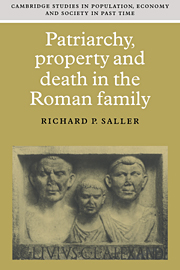Book contents
- Frontmatter
- Contents
- List of tables
- Preface
- Abbreviations
- 1 Introduction: approaches to the history of the Roman family
- Part I Roman life course and kinship: biology and culture
- Part II Roman family and culture: definitions and norms
- Part III The devolution of property in the Roman family
- Bibliography
- Index
- Cambridge Studies in Population, Economy and Society in Past Time
Part I - Roman life course and kinship: biology and culture
Published online by Cambridge University Press: 23 November 2009
- Frontmatter
- Contents
- List of tables
- Preface
- Abbreviations
- 1 Introduction: approaches to the history of the Roman family
- Part I Roman life course and kinship: biology and culture
- Part II Roman family and culture: definitions and norms
- Part III The devolution of property in the Roman family
- Bibliography
- Index
- Cambridge Studies in Population, Economy and Society in Past Time
Summary
The Antonine senator Fronto wrote a moving account of his anguish over the deaths in infancy of his first five offspring and of his first grandson – an experience that would be so rare in the contemporary developed world that it would raise suspicions of criminal wrongdoing. High infant mortality is only one aspect of the very different patterns of births and deaths that separate our own family experiences from those of antiquity. Those demographic patterns are fundamental to an understanding of Roman family relations, and yet are problematic to study. Demography is a discipline based on quantitative data. For the Roman historian, the obstacle to demographic study is the lack of reliable statistics from antiquity and the nearly complete lack of samples of data from which meaningful statistics may be constructed. At the level of family and household, we have records neither of births, marriages, and deaths – the basis of reconstitution studies – nor of household census data for the empire outside Egypt. The absence of solid data may suggest the impossibility of worthwhile demographic studies to many classicists, accustomed to constructing arguments from fixed texts, though of course the fixity of the classical text is sometimes an illusion.
Against any attempt at demographic understanding, the skeptical classical scholar will point out that comparative evidence from other societies cannot supply the data that we do not possess for ancient Rome. The argument against filling in the blanks from comparative material is certainly valid for the types of history usually pursued by classical historians.
- Type
- Chapter
- Information
- Patriarchy, Property and Death in the Roman Family , pp. 9 - 11Publisher: Cambridge University PressPrint publication year: 1994



